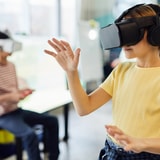
Much ado has been made about Apple entering the world of virtual reality (VR), but that's not the full story. Cupertino spent the last few years investing in augmented reality (AR) tech on the iPhone where visuals are overlaid on top of the real world, so that's an important aspect to remember. With both VR and AR together, we get mixed reality — that's almost certainly going to be Apple's pitch.
It's safe to expect a proper announcement as WWDC kicks off on Monday, but the leaks have been prolific this time around. Why wait for Tim Cook to get up on stage? Join me as I work through the most important information about Apple's shiny new hardware so you can decide exactly the right level of hype to have on day one.
The display
You want more, I will give you more: Micro OLED specs for Apple's AR/VR headset:
— Ross Young (@DSCCRoss) May 30, 2023
1.41" in diagonal
4000 PPI
>5000 nits of brightness
Ross Young, head of Display Supply Chain Consultants, came out with a list of some extremely impressive screen specs he's expecting for this mixed reality headset. His word caries a good bit of weight behind it, but I'm still kind of stunned by some of the information.
Five-thousand nits is absolutely off the charts when it comes to maximum screen brightness. I'm used to seeing 1,000 nits for a nice OLED TV, and some other kinds of displays can double or triple that, but 5K right next to your eyeballs is a lot TBH. Let's hope there are some built-in restrictions so people don't go too hard here.
The other important bit of info from Ross is the wild expectation of a 4K resolution per eye. Sony's impressive PSVR2, in comparison, only offers a resolution of 2000x2040 per eye. The horsepower needed to drive resolutions that high is going to be outlandish. Hopefully, Apple's chips are up for the challenge.
Battery
The Wall Street Journal came out a few weeks ago with the detail that the headset will come with a battery pack that you can attach to your belt. This obviously conflicts with the design ethos of Apple, and it's shockingly clumsy when compared to the lower-end Oculus Quest 2.
Since the consensus seems to be that this will primarily serve as a stand-alone device that needs to run the games and apps locally, there's going to be a huge power suck. If they had put that extra battery in the headset itself, it would weigh everything down.
Still, it feels odd for a company that has historically prioritized slim builds over raw battery life to make such a massive compromise to ship as quickly as possible.
Pricing
Most of the leaks seem to point towards a price point of about $3,000 — way, way too much for normal people. In comparison, the introductory model of the stand-alone Oculus Quest 2 just dropped to $300, and the Quest 3 is coming later this year at $500. Want a higher-end PlayStation VR2? That's $550 for the headset and another $400 for the console to run the games. Heck, even the beefy Meta Quest Pro is down to $1,000.
For one of Apple's devices, you could buy 10 Quest 2s, six Quest 3s, three PSVR2-PS5 combos or a Quest Pro alongside a nice gaming PC. That's hard to swallow even if you can afford the ridiculously high cost.
Apps
Bloomberg's Mark Gurman, one of the best founts of Apple leaks, explained that his sources believe that millions of iPad apps will work on the device right away, but there will be a number of apps specifically designed to take advantage of the VR/AR hardware.
Fitness and wellness apps are big callouts from Gurman. Users will be able to meditate while being engulfed with soothing audiovisual elements, or break a sweat with Fitness+'s live instruction.
Of course, video calls and work collaboration will be present as well, since the business market is obviously where a lot of mixed reality research has focused. Will companies actually shell out $3,000 for anyone other than the executives? Probably not.
Value
In the end, this first edition simply cannot offer enough value for most people to make it worthwhile.
Even if Apple does eventually become a massive player in the VR/AR market, it's going to take time, hardware revisions and cost cutting to get there. Expect to see a heck of a demo on Monday, but keep that credit card sheathed.
[Image: Vanessa Loring, Pexels]


